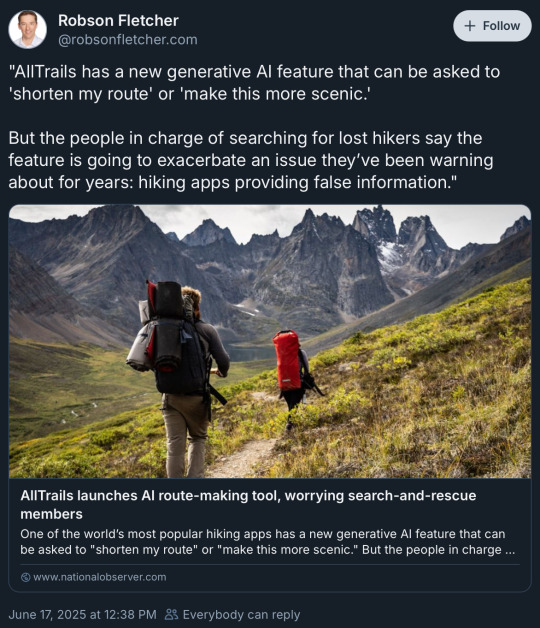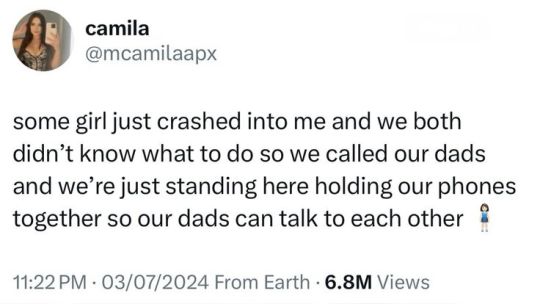Kayla 31 adhd fantasy/YA Header: hand-painted-5tars icon: Jazybee
Don't wanna be here? Send us removal request.
Text
writing is so funny because i could write nonstop for 9hrs and then hit a block where im like "how do i transition between this moment and the next?" and then i just dont touch it for 6 months
32K notes
·
View notes
Text
This may be the worst use of LLMs anyone has attempted, ever. Up there with recognizing mushrooms.

41K notes
·
View notes
Text
so the childhood yearning to live in a fantasy world just never goes away huh
22K notes
·
View notes
Text
Entity of pure hate and malice just did a cute pose and made heart hands after killing everyone in its path
21K notes
·
View notes
Text
how many years into ppl demanding complete moral purity from their protagonists will we end up with just milquetoast therapyspeak mouthpieces in place of actual characters
2K notes
·
View notes
Text
How to use Em Dash (—) and Semi Colon ( ; )
Since the ai accusations are still being thrown around, here's how i personally like to use these GASP ai telltales. 🦄✨
Em Dashes (—)
To emphasize a shift / action / thought.
They're accusing us—actually accusing us—of using AI.
To add drama.
They dismissed our skills as AI—didn't even think twice, the dimwits—and believed they were onto something.
To insert a sudden thought. Surely they wouldn't do that to us—would they?
To interrupt someone's speech. "Hey, please don't say that. I honed my craft through years of blood and tears—" "Shut up, prompter."
To interrupt someone's thoughts / insert a sudden event.
We're going to get those kudos. We're going to get those reblogs—
A chronically online Steve commented, “it sounds like ai, idk.”
Semi Colons ( ; )
To join two closely related independent sentences / connect ideas.
Not only ChatGPT is capable of correct punctuation; who do you think it learned from in the first place?

Ultimate pro tip: use them whenever the fuck you want. You don't owe anyone your creative process. 🌈

10K notes
·
View notes
Text
Zoom In, Don’t Glaze Over: How to Describe Appearance Without Losing the Plot
You’ve met her before. The girl with “flowing ebony hair,” “emerald eyes,” and “lips like rose petals.” Or him, with “chiseled jawlines,” “stormy gray eyes,” and “shoulders like a Greek statue.”
We don’t know them.
We’ve just met their tropes.
Describing physical appearance is one of the trickiest — and most overdone — parts of character writing. It’s tempting to reach for shorthand: hair color, eye color, maybe a quick body scan. But if we want a reader to see someone — to feel the charge in the air when they enter a room — we need to stop writing mannequins and start writing people.
So let’s get granular. Here’s how to write physical appearance in a way that’s textured, meaningful, and deeply character-driven.
1. Hair: It’s About Story, Texture, and Care
Hair says a lot — not just about genetics, but about choices. Does your character tame it? Let it run wild? Is it dyed, greying, braided, buzzed, or piled on top of her head in a hurry?
Good hair description considers:
Texture (fine, coiled, wiry, limp, soft)
Context (windblown, sweat-damp, scorched by bleach)
Emotion (does she twist it when nervous? Is he ashamed of losing it?)
Flat: “Her long brown hair framed her face.”
Better: “Her ponytail was too tight, the kind that whispered of control issues and caffeine-fueled 4 a.m. library shifts.”
You don’t need to romanticise it. You need to make it feel real.
2. Eyes: Less Color, More Connection
We get it: her eyes are violet. Cool. But that doesn’t tell us much.
Instead of focusing solely on eye color, think about:
What the eyes do (do they dart, linger, harden?)
What others feel under them (seen, judged, safe?)
The surrounding features (dark circles, crow’s feet, smudged mascara)
Flat: “His piercing blue eyes locked on hers.”
Better: “His gaze was the kind that looked through you — like it had already weighed your worth and moved on.”
You’re not describing a passport photo. You’re describing what it feels like to be seen by them.
3. Facial Features: Use Contrast and Texture
Faces are not symmetrical ovals with random features. They’re full of tension, softness, age, emotion, and life.
Things to look for:
Asymmetry and character (a crooked nose, a scar)
Expression patterns (smiling without the eyes, habitual frowns)
Evidence of lifestyle (laugh lines, sun spots, stress acne)
Flat: “She had a delicate face.”
Better: “There was something unfinished about her face — as if her cheekbones hadn’t quite agreed on where to settle, and her mouth always seemed on the verge of disagreement.”
Let the face be a map of experience.
4. Bodies: Movement > Measurement
Forget dress sizes and six packs. Think about how bodies occupy space. How do they move? What are they hiding or showing? How do they wear their clothes — or how do the clothes wear them?
Ask:
What do others notice first? (a presence, a posture, a sound?)
How does their body express emotion? (do they go rigid, fold inwards, puff up?)
Flat: “He was tall and muscular.”
Better: “He had the kind of height that made ceilings nervous — but he moved like he was trying not to take up too much space.”
Describing someone’s body isn’t about cataloguing. It’s about showing how they exist in the world.
5. Let Emotion Tint the Lens
Who’s doing the describing? A lover? An enemy? A tired narrator? The emotional lens will shape what’s noticed and how it’s described.
In love: The chipped tooth becomes charming.
In rivalry: The smirk becomes smug.
In mourning: The face becomes blurred with memory.
Same person. Different lens. Different description.
6. Specificity is Your Superpower
Generic description = generic character. One well-chosen detail creates intimacy. Let us feel the scratch of their scarf, the clink of her earrings, the smudge of ink on their fingertips.
Examples:
“He had a habit of adjusting his collar when he lied — always clockwise, always twice.”
“Her nail polish was always chipped, but never accidentally.”
Make the reader feel like they’re the only one close enough to notice.
Describing appearance isn’t just about what your character looks like. It’s about what their appearance says — about how they move through the world, how others see them, and how they see themselves.
Zoom in on the details that matter. Skip the clichés. Let each description carry weight, story, and emotion. Because you’re not building paper dolls. You’re building people.
8K notes
·
View notes
Text
yesss girl! reorganize your entire plot at 3 a.m. during an existential crisis! brilliant idea!
1K notes
·
View notes
Text
Why isn't "too scary" a good enough reason to never drive a car
39K notes
·
View notes
Text
id die for the internet archive over my country
36K notes
·
View notes
Text
everyone needs a creative outlet to stick a creative fork into
88K notes
·
View notes
Link
Just a little PSA for all our mental health (and chronic pain*) spoonies out there! A lot of doctors neglect to mention this little side effect, which means a lot of us are suffering extra from the heat without knowing why.
*Many psych meds are used to treat chronic pain as well, if you didn’t know!
35K notes
·
View notes
Text
"you're the writer, you control how the story goes" no not really. i wrote the first sentence and then my characters said "WE WILL TAKE IT FROM HERE" and promptly swerved into an electrical fence.
48K notes
·
View notes
Text
Would anyone be interested if I put together a post on how to write a scientist/engineer/techy/smart-guy type character? What would y'all want to know?
1K notes
·
View notes
Text
anyone else wish they would get roped into a freaky friday body swap situation just for the hope that the other person will go "oh jesus fuck how do you live like this" and instantly validate your feelings of being Strange and Built Wrong.
50K notes
·
View notes

